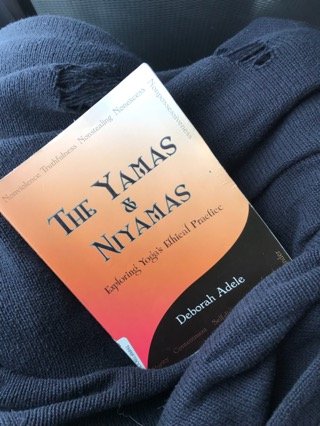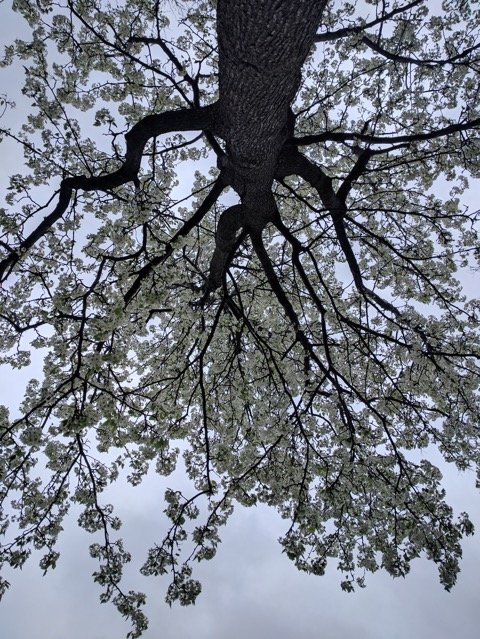Climbing the First Limb of the Eight Limbs of Yoga: The Yamas and Niyamas: Ahimsa
Hello friends! As I discussed in my last post, there are eight limbs of yoga; eight different levels of mastery. The first is called The Yamas and Niyamas. These are philosophies that apply to our interactions with ourselves and the rest of the world. They involve creating awareness and effort in navigating through our relationships with ourselves and others, as well as evaluating our behaviors, attitudes, and perspective. If you never make it onto a yoga mat, yet you can make it through learning about the Yamas and Niyamas, your life will be forever changed, for the better.
There’s a book on this topic that I have found to be extremely helpful, inspiring, as well as concise. If you have an interest to go deeper into this subject, I would highly recommend that you read it. It’s called The Yamas and Niyamas: Exploring Yoga’s Ethical Practice, written by Deborah Adele.

Now let’s get into our first Yama!
Ahimsa: Nonviolence
I mentioned briefly in my last post that Ahimsa is hugely important in yoga. Why is that? Why is any of this important? We are represented by our actions. What we do, how we act, how we treat other people, the choices we make- they reflect upon us more than any of our thoughts, feelings, or words. So it is important to live consciously. To understand why we do what we do and to actively choose how and why we do it.
Living a nonviolent life is more nuanced than not killing and doing physical harm. Nonviolence applies to our internal dialogue, how we speak to others, and what our intentions are behind helping other people. Just to name a few. Our capacity for upholding Ahimsa in our lives is directly related to practicing courage, balance, self-love, and compassion for others.
See, striving for a nonviolent life takes more than just preemptively evaluating your actions and words. It means working on yourself and your relationship with the world in such a way that you have the energy and innate desire to practice nonviolence in your life. It’s a lot harder to be kind to yourself and other people when you feel tired, out of balance, powerless, and insecure. You’re much more likely to speak and act with irritation, to have angry outbursts, and to be mean to yourself.
So how do we prepare ourselves? There are five key components. First up,
Courage
Courage is not the absence of fear, but the will to act in spite of it. Most things you are afraid of are either unlikely to happen or unlikely to kill you. Yet these fears we have limit us. They limit who we talk to, what we say, where we go, what we do, and, most importantly, how we think. If we open ourselves up to the world more, we become less afraid of it, and more understanding of it. The more understanding you have of the world, the less inclined you will be to act out of fear or insecurity. Fear breeds violence. Rise up with courage and embrace the world and everything it has to teach you!

Balance
Imbalance is a prime cause of violence. When we’re unbalanced, everything we do comes from an unstable mindset. We are mentally and emotionally compromised. Whether it’s your eating habits, work, leisurely proclivities, time alone- if you’re not finding balance in the components of your life, it will be more difficult to live it.
Balance does not look the same for everyone. What feels like a balanced lifestyle to you might feel like a rollercoaster to me. Therefore, it’s important to bring awareness into the relationship you have with yourself and your life. To become more understanding of your own tendencies and needs, and to respond accordingly.
Powerlessness
Feeling powerless usually preludes aggressive, frustrated behavior. Because when we feel powerless, we feel like there’s nothing we can do about our situation and we go into fight, flight, or freeze mode. What can we do in those situations?
Ahimsa encourages us to challenge the feeling of powerlessness rather than giving into it. Can you alter your perspective of the situation? Maybe just take a moment to practice gratitude and appreciation for this opportunity to grow and to experience life in this moment. Stepping outside of our emotions and evaluating our experience from an observational mindset creates space for responding vs reacting to our environment.

Self-Love
Our capacity to show compassion and understanding towards others often coincides with our ability to show compassion and acceptance towards ourselves. Our outward attitude is a reflection of what’s going on on the inside. Deborah Adele explains this well in her book, The Yamas and Niyamas:
“We can have hearts that are full of love for others, and intentions to love that are pure. But the truth is, we will express that love for others by treating them the same way we treat ourselves. Love lies at the core of nonviolence and begins with our love of self. Not a love that is ego-centric but a love that is forgiving and lenient; a love that sees the humor in the imperfections and accepts the fullness of the human experience. Only when we find this love for all the parts of ourselves, can we begin to express fully the love that wells up inside of us for others. Finding this love for all the parts of ourselves means we have to forgive ourselves. Without forgiveness, we carry guilt like a heavy burden around our hearts. Guilt holds our love for self and others hostage and keeps us bound to a one-sided expectation of the human experience.”
Take a moment to let all of that sink in.
Learning to love yourself -as you are- can be a huge undertaking. Especially the “as you are” part. A lot of us hold our acceptance of ourselves at the end of a long journey of fixing ourselves or becoming some imaginary version of ourselves that we think is better. We get trapped in these vicious cycles of trying to become the person we want to love rather than loving the person we are. If you learn to love yourself as you are, every step forward is more stable and confident.
Compassion
Do you know the definition of compassion? The Merriam-Webster dictionary describes compassion as “sympathetic consciousness of others’ distress together with a desire to alleviate it.” To do this, we have to be able to see them as other people with lives just as meaningful as our own. You may not see it, but everyone has suffered through painful experiences, just like you. Recalling this truth makes it easier to practice compassion.
Now that we’ve made it through the basics of equipping yourself with the tools and capacity to practice Ahimsa, let’s touch on the details of acting it out.

Helping or Hurting?
It’s important to recognize that we are human and we are fallible. Even a person with the purest intent to show compassion for others can accidentally hurt someone rather than helping them. Here we shall discern the difference between “helping” and “supporting” someone. “Helping” implies that the other person is incapable of taking care of and making decisions for themselves. That in of itself is a subtle form of violence. And in “helping” others, sometimes we take away the learning and growing experience they would have had. “Supporting” others indicates that we respect the other person’s autonomy and what they want and we are simply contributing to their objectives.
Additionally, remember to evaluate your motivation behind showing compassion for others. Is it to make you feel good? To show off to others? To make up for wrongs you’ve done? It should come from nowhere else other than an honest desire to honor other people and show love for them. Otherwise your good action has bad intent.
To re-cap! Ahimsa, the first of the Yamas, calls for us to practice nonviolence- with ourselves and with others. By having a balanced body and mindset rooted in courage, compassion, self-love and acceptance, we are much more able to interact with the rest of the world peacefully and lovingly.
Deborah Adele’s book includes exercises you can do to practice each of the Yamas and Niyamas. I have followed a few of them and find them to be incredibly helpful. I will briefly list my favorites she suggested for Ahimsa. She recommends practicing each exercise for a full week.
Exercise One: Practice courage by doing things that push you out of your comfort zone. Find excitement in the fact that you’re a little scared but doing it anyway.
Exercise Two: Guard your balance as the most important objective of each day. Do you need more or less sleep? More or less alone time? Are you eating enough or too much? Don’t look to others to decide what you need more or less of. Look within yourself, the answer is there.
Thank you for taking the time to read about yoga stuff. I like this sort of thing.
You have received an upvote (from @rycharde) and a resteem (from @accelerator) as part of the Minnows Accelerator Project.
You can see your entry here.
You have been added to the Fanbase on SteemAuto and will be supported with further upvotes for a few weeks.
You are also being followed by @accelerator and may receive further upvotes when your article is added to one of our curation posts.
All of this is free and part of MAP's mission to support quality content creators.
If you would like to participate in the MAP community, then come and have a chat at our discord "waiting room": https://discord.gg/rSVcWaH
Ahimsa is incredibly difficult and takes a long time to internalize. Even though I feel like I fail in it a lot, I still find it very rewarding.
Thanks to @seyiodus, this post was resteemed and highlighted in today's edition of The Daily Sneak.
Thank you for your efforts to create quality content!